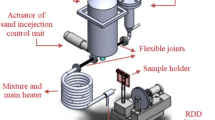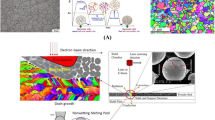Abstract
The process of amorphous silica clusters impact on a crystal silicon substrate is studied by molecular dynamics simulation, focusing on the energy transfer between clusters and the substrate under different impact conditions such as cluster size, impact velocity, and incidence angle. The impact process is divided into cluster deformation stage, cluster resilience stage, and cluster rebound stage according to the courses of energy change during the impact process. The simulation elucidates that the time of impact process of every cluster is only related to cluster size and is independent of impact velocity and incidence angle. The translational energy loss of the cluster and the potential energy increment of the substrate during cluster deformation stage, and the dissipation energy of system are independent of cluster size under the same impact energy and incidence angle. And the translational energy loss of the cluster during cluster rebound stage changes from energy absorption to energy release after the incidence angle becomes more than 60°. The rotational energy of the cluster may be omitted when the incidence angle is less than 15°. The ratios of the rotational energy increment of the cluster, the kinetic energy increment, and the potential energy increment of the substrate to the translational energy loss of the cluster are obviously influenced by impact conditions. And the ratios of the increment of the other categories of energy to the translational energy loss of the cluster are not sensitive to impact conditions.
















Similar content being viewed by others
References
Anders C, Urbassek HM, Johnson RE (2004) Linearity and additivity in cluster-induced sputtering: a molecular-dynamics study of van der Waals bonded systems. Phys Rev B 70:155404
Aoki T, Matsuo J, Inspevo Z, Yamada I (1997) Molecular dynamics simulation of damage formation by cluster ion impact. Nucl Instrum Methods Phys Res B 121:49–52
Aoki T, Matsuo J (2004) Surface structure dependence of impact processes of gas cluster ions. Nucl Instrum Methods Phys Res B 216:185–190
Aoki T, Matsuo J (2005) Molecular dynamics simulations of sequential cluster ion impacts. Nucl Instrum Methods Phys Res B 228:46–50
Aoki T, Matsuo J (2006) Molecular dynamics study of particle emission by reactive cluster ion impact. Appl Surf Sci 252:6466–6469
Carroll SJ, Nellist PD, Palmer RE, Hobday S, Smith R (2000) Shallow implantation of “size-selected” Ag clusters into graphite. Phys Rev Lett 84:2654–2657
Cleveland CL, Landman U (1992) Dynamics of cluster–surface collisions. Science 257:355–361
Duan FL, Luo JB, Wen SZ, Wang JX (2005) Atomistic structural change of silicon surface under a nanoparticle collision. Chin Sci Bull 50:1661–1665
Haberland H, Insepov Z, Moseler M (1995) Molecular-dynamics simulation of thin-film growth by energetic cluster impact. Phys Rev B 51:11061–11067
Henkel M, Urbassek HM (1998) Ta cluster bombardment of graphite: molecular dynamics study of penetration and damage. Nucl Instrum Methods Phys Res B 145:503–508
Hensel H, Urbassek HM (1998) Implantation and damage under low-energy Si self-bombardment. Phys Rev B 57:4756–4763
Insepov Z, Yamada I (1999) Surface processing with ionized cluster beams: computer simulation. Nucl Instrum Methods Phys Res B 153:199–208
Insepov Z, Manory R, Matsuo J, Yamada I (2000) Proposal for a hardness measurement technique without indentor by gas-cluster-beam bombardment. Phys Rev B 61:8744–8752
Kubota A, Mimura H, Inagaki K, Mori Y, Yamauchi K (2006) Effect of particle morphology on removal rate and surface topography in elastic emission machining. J Electrochem Soc 153:G874–G878
Mori Y, Yamauchi K, Endo K, Ide T, Toyota H, Nishizawa K, Hasegawa M (1990) Evaluation of elastic emission machined surfaced by scanning tunneling microscopy. J Vac Sci Technol A 8:621–624
Moseler M, Rattunde O, Nordiek J, Haberland H (2000) On the origin of surface smoothing by energetic cluster impact: molecular dynamics simulation and mesoscopic modeling. Nucl Instrum Methods Phys Res B 164–165:522–536
de la Rubia TD, Gilmer GH (1995) Structural transformations and defect production in ion implanted silicon: a molecular-dynamics simulation study. Phys Rev Lett 74:2507–2510
Takami S, Suzuki K, Kubo M, Miyamoto A (2001) The fate of a cluster colliding onto a substrate. J Nanopart Res 3:213–218
Thomas JC, Aderjan R, Kissel R, Urbassek HM (2000) Sputtering of Au(111) induced by 16-keV Au cluster bombardment: spikes, craters, later emission, and fluctuations. Phys Rev B 62:8487–8493
Voronin GA, Pantea C, Zerda TW, Wang L, Zhao Y (2003) In situ X-ray diffraction study of silicon at pressures up to 15.5 GPa and temperatures up to 1073 K. Phys Rev B 68:020102
Watanabe T, Fujiwara H, Noguchi H, Hoshino T, Ohdomari I (1999) Novel interatomic potential energy function for Si, O mixed systems. Jpn J Appl Phys 38:L366–L369
Watanabe T, Yamasaki D, Tatsumuar K, Ohdomari I (2004) Improved interatomic potential for stressed Si, O mixed systems. Appl Surf Sci 234:207–213
Yamaguchi Y, Gspann J (2002) Large-scale molecular dynamics simulations of cluster impact and erosion process on a diamond surface. Phys Rev B 66:155408
Yamauchi K, Hirose K, Goto H, Sugiyama K, Inagaki K, Yamamura K, Sano Y, Mori Y (1999) First-principle simulations of removal process in EEM (elastic emission machining). Comp Mater Sci 14:232–235
Acknowledgments
The authors wish to thank T. Watanabe, Ph.D., for explaining how to use his potential function. The authors would also like to thank L. Huang, Ph.D., and F. Duan, Ph.D., for their helpful discussions on the preparation of the silica cluster. This research is supported by National Natural Science Foundation of China (grant no. 50775121) and the National Key Basic Research Program of China (grant no. 2003CB716200).
Author information
Authors and Affiliations
Corresponding author
Rights and permissions
About this article
Cite this article
Chen, R., Luo, J., Guo, D. et al. Energy transfer under impact load studied by molecular dynamics simulation. J Nanopart Res 11, 589–600 (2009). https://doi.org/10.1007/s11051-008-9398-8
Received:
Accepted:
Published:
Issue Date:
DOI: https://doi.org/10.1007/s11051-008-9398-8




